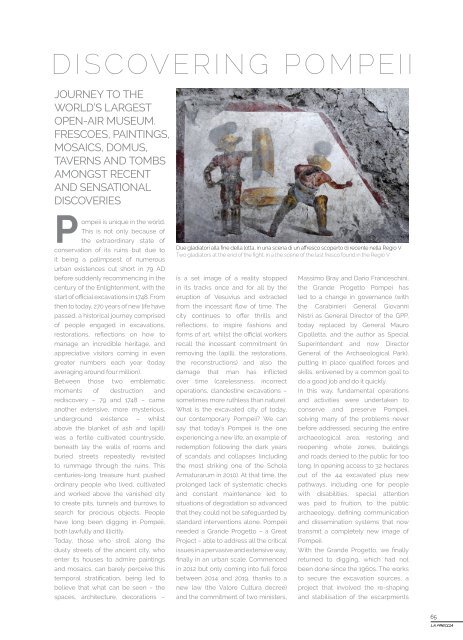Create successful ePaper yourself
Turn your PDF publications into a flip-book with our unique Google optimized e-Paper software.
DISCOVERING POMPEII<br />
JOURNEY TO THE<br />
WORLD’S LARGEST<br />
OPEN-AIR MUSEUM.<br />
FRESCOES, PAINTINGS,<br />
MOSAICS, DOMUS,<br />
TAVERNS AND TOMBS<br />
AMONGST RECENT<br />
AND SENSATIONAL<br />
DISCOVERIES<br />
Pompeii is unique in the world.<br />
This is not only because of<br />
the extraordinary state of<br />
conservation of its ruins but due to<br />
it being a palimpsest of numerous<br />
urban existences cut short in 79 AD<br />
before suddenly recommencing in the<br />
century of the Enlightenment, with the<br />
start of official excavations in 1748. From<br />
then to today, 270 years of new life have<br />
passed, a historical journey comprised<br />
of people engaged in excavations,<br />
restorations, reflections on how to<br />
manage an incredible heritage, and<br />
appreciative visitors coming in even<br />
greater numbers each year (today<br />
averaging around four million).<br />
Between those two emblematic<br />
moments of destruction and<br />
rediscovery – 79 and 1748 – came<br />
another extensive, more mysterious,<br />
underground existence – whilst<br />
above the blanket of ash and lapilli<br />
was a fertile cultivated countryside,<br />
beneath lay the walls of rooms and<br />
buried streets repeatedly revisited<br />
to rummage through the ruins. This<br />
centuries-long treasure hunt pushed<br />
ordinary people who lived, cultivated<br />
and worked above the vanished city<br />
to create pits, tunnels and burrows to<br />
search for precious objects. People<br />
have long been digging in Pompeii,<br />
both lawfully and illicitly.<br />
Today, those who stroll along the<br />
dusty streets of the ancient city, who<br />
enter its houses to admire paintings<br />
and mosaics, can barely perceive this<br />
temporal stratification, being led to<br />
believe that what can be seen – the<br />
spaces, architecture, decorations –<br />
Due gladiatori alla fine della lotta, in una scena di un affresco scoperto di recente nella Regio V<br />
Two gladiators at the end of the fight, in a the scene of the last fresco found in the Regio V<br />
is a set image of a reality stopped<br />
in its tracks once and for all by the<br />
eruption of Vesuvius and extracted<br />
from the incessant flow of time. The<br />
city continues to offer thrills and<br />
reflections, to inspire fashions and<br />
forms of art, whilst the official workers<br />
recall the incessant commitment (in<br />
removing the lapilli, the restorations,<br />
the reconstructions) and also the<br />
damage that man has inflicted<br />
over time (carelessness, incorrect<br />
operations, clandestine excavations –<br />
sometimes more ruthless than nature).<br />
What is the excavated city of today,<br />
our contemporary Pompeii? We can<br />
say that today’s Pompeii is the one<br />
experiencing a new life, an example of<br />
redemption following the dark years<br />
of scandals and collapses (including<br />
the most striking one of the Schola<br />
Armaturarum in 2010). At that time, the<br />
prolonged lack of systematic checks<br />
and constant maintenance led to<br />
situations of degradation so advanced<br />
that they could not be safeguarded by<br />
standard interventions alone. Pompeii<br />
needed a Grande Progetto – a Great<br />
Project – able to address all the critical<br />
issues in a pervasive and extensive way,<br />
finally in an urban scale. Commenced<br />
in 2012 but only coming into full force<br />
between 2014 and 2019, thanks to a<br />
new law (the Valore Cultura decree)<br />
and the commitment of two ministers,<br />
Massimo Bray and Dario Franceschini,<br />
the Grande Progetto Pompei has<br />
led to a change in governance (with<br />
the Carabinieri General Giovanni<br />
Nistri as General Director of the GPP,<br />
today replaced by General Mauro<br />
Cipolletta, and the author as Special<br />
Superintendent and now Director<br />
General of the Archaeological Park),<br />
putting in place qualified forces and<br />
skills, enlivened by a common goal to<br />
do a good job and do it quickly.<br />
In this way, fundamental operations<br />
and activities were undertaken to<br />
conserve and preserve Pompeii,<br />
solving many of the problems never<br />
before addressed, securing the entire<br />
archaeological area, restoring and<br />
reopening whole zones, buildings<br />
and roads denied to the public for too<br />
long. In opening access to 32 hectares<br />
out of the 44 excavated plus new<br />
pathways, including one for people<br />
with disabilities, special attention<br />
was paid to fruition, to the public<br />
archaeology, defining communication<br />
and dissemination systems that now<br />
transmit a completely new image of<br />
Pompeii.<br />
With the Grande Progetto, we finally<br />
returned to digging, which had not<br />
been done since the 1960s. The works<br />
to secure the excavation sources, a<br />
project that involved the re-shaping<br />
and stabilisation of the escarpments<br />
65

















